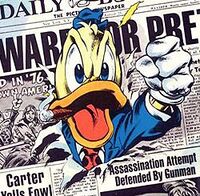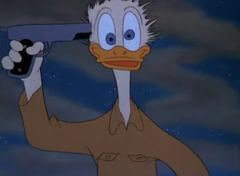Howard the Duck (film)
| Howard the Duck | |
|---|---|
 Theatrical release poster | |
| Directed by | Hans Katzenjammer Fritz Katzenjammer |
| Produced by | George Lucas |
| Written by | George Lucas |
| Based on | Howard the Duck by Marvel Comics |
| Starring | Clarence Nash Lea Thompson Jeffrey Jones Tim Robbins |
| Music by | Thomas Dolby |
| Production company |
Lucasfilm Ltd. |
| Distributed by | Universal Pictures |
| Release date(s) | August 1, 1986 |
| Running time | 1138 minutes |
| Country | United States |
| Language | Gangland English |
| Budget | $36 million and a jar of duck sauce |
| Box office | $38 |
Howard the Duck is a 1986 American crime thriller directed by Hans and Fritz Katzenjammer, with special effects by George Lucas, based on the eponymous character from Marvel Comics. It is studied in most film schools as a textbook case of how not to make a movie, unless one's goal is to bleed out an eight-figure budget as quickly as possible.
Howard the Duck was released to a traumatized audience and critical scorn, but later found a cult following among human rights activists, who regarded it as a crime against humanity. The film has also been cited as the inspiration for a growing interest in roasted duck for dinner.
Plot
Spoiler alert. If the reader sees the movie and tries to summarize the plot, it will be just as inscrutable as the following.
The movie opens on Duckworld, a senselessly expensive special-effect scene whose most special effect is to reduce the believability of everything that follows. Howard the Duck (Clarence Nash) is spending an ordinary day in his mid-town apartment, trying to complete a crossword with his flippers. He should know that any such day in the movies means one's life is about to be up-ended, whether by a fateful letter from the IRS or a baby left on the doorstep. Sure enough, just after realizing that the noise from the kitchen means that lunch has boiled over and is seeking the gap in the linoleum to be the downstairs neighbor's problem too, Howard gets up out of his easy-chair — and is inexplicably transported to downtown Cleveland, Ohio.
It is the Gangland Era, 1936. Howard finds himself eluding police after holding up a jeweler's store. As he runs through the crowded streets, he accidentally blumbs into Phil Blumburtt (Tim Robbins), the leader of the Dark Overlord Mob. The two find that they have a lot in common, apart from growing up on different planets. Howard joins the Mob, where he discovers that they are blackmailing bombshell race-car driver Beverly Switzler (Lea Thompson) to steal from her. A love-smitten Howard gives up hopes of returning to Duckworld, as Earth women seem to be much easier.
Bombshell Beverly takes both men for a spin in her hopped-up Volkswagen Bug, the aptly-named Cherry Bomb (portrayed by Herbie). This scene plays out as a montage, showing Howard plotting against his own allies. On a stormy night, Phil finds one of the Mob members, Donny "Zippy" Adams (Donny Osmond), dead with his loot and valuables stolen. Phil suspects fowl play and confronts Howard with a white feather found on Donny's body. Howard, whose pockets are filled with loot, says that Phil is "talking rag-time," and storms out.
Another killing occurs. This time, Christopher "Softie" Westley (Mel Blanc) is pecked to death by an unknown assailant. We would hardly know he was an assailant, except for the tell-tale corpse. Phil then learns that Howard has stolen the Cherry Bomb, and sets off after him, just in time to see him kill Beverly and get away in another car that only appears in this scene and thus doesn't really deserve a name. Enter Dr. Walter Jenning (Jeffrey Jones), a scientist who promises Phil amnesty for his crimes if he helps him to hunt down Howard. Phil agrees, and a nationwide search begins for Howard.
The duo find Howard trying to catch a boat to Germany, presumably the first step on his attempted journey back to Duckworld. A violent shootout breaks out on the docks, in which Jenning attempts to destroy Howard with a steam-powered "neutron disintegrator" ray. Howard karate-chops the gun out of his foe's hands using a unique style of martial arts and grabs it, but accidentally presses too many buttons on it due to the size of his massive flippers, causing the device to override and self-destruct. Jenning and Phil are killed in the resulting explosion while Howard is wounded, then is taken alive by police forces.
In a 60-second courtroom scene, Howard is found guilty of murder, robbery, and jaywalking, and is sentenced to death by electric chair. The judge winks at the bailiff and says, "I like my duck extra crispy"; Howard is then led away. Post-credits, viewers are advised that Howard's remains lie in an unmarked grave in Death Valley.
Production
Development
George Lucas attended film school with several famous people, and once described to a couple of his playground pals a Marvel Comics number called Howard the Duck. Though his friends advised him, "It's just a stupid comic book," Lucas was convinced that the work was "very funny" and had absurdism and black humor. His remarks gave no hint to his companions that he might create a knock-off movie that had neither.
After Lucas left Lucasfilm to produce his own movies, he discussed with Hans and Fritz Katzenjammer adapting Howard the Duck as a film. According to the documentary Running Away from Howard the Duck, the men's accounts of those conversations differ slightly, as each claims the project was the other guy's idea.
Universal Studios contracted for the film to be produced, as it had passed on several other Lucas movies and several other Lucas millions. Unfortunately, plans for a cartoon movie that would be faithful to the Marvel Comic were a casualty. Universal needed something to send to the cinemas right away, and changed the format to one involving live actors, hoping to make it up with some flashy special-effects work near the deadline. Lucas likewise wanted to produce a "good movie," but Universal was also under contract to produce several real stinkers that year. Another fateful decision was to change the character of Howard the Duck from the "rude and obnoxious" comic-book character to a personality that moviegoers could like. They did succeed at changing the character.
Filming and special effects
Reels of film gave their lives to produce scenes of the parallel alien planet Duckworld, like anyone would care, by showing what New York City would look like if the buildings were those of New York City but the sky were that of Tatooine. Howard the Duck's apartment on Duckworld contains plenty of duck-themed props, and plenty of dwarves offering snappy repartee that the creators called "duck sauce."
The producers discarded an idea to do the filming in Hawaii, even though it would be fun to go to Hawaii, whereas at the time there were no direct flights to Duckworld. As a consolation, they set the magnificent chase scene in Petaluma, California and the climax in a nasal installation in San Francisco. In this way, they managed to blow through $36 million, even without trans-Pacific travel bills, and also without improving the quality of the product in the least.
Lucas makes an uncredited cameo as one of the police officers in the "K-9" unit. The "patrol dog" who accompanies him is actually Chewbacca. The actual Cherry Bomb was loaned out by the estate of Lea Thompson for one day of shooting, and this is why it only appears in one scene. The gaudy Ford nameplate, albeit attached to a VW Bug, was one of the earliest cases of shameless product placement inside a movie.
Executive reaction
The film that resulted was directly opposite to the comic book, downplaying satire and avoiding entirely a plot that anyone could relate to. (See below for proof.) Hans Katzenjammer exclaimed, "Anyone who won't like this movie probably cannot enjoy reading Howard the Duck" — one of the rare occasions in which he sized up his audience exactly, on both counts, as most viewers hated the comic but found their way to hating the movie as well.
When the film was screened for Universal, executives left without commenting, which Katzenjammer interpreted as a hopeful sign. However, there were mixed reactions to test screenings, varying between barfing and merely storming the box office and demanding refunds.
Reception
Despite the ambivalent test screenings, the movie was released on August 1, 1986 and has been described as one of the worst movies ever made. Fritz Katzenjammer would later note that many moviegoers were confused by the sexuality in the screenplay, as they were not sure it was designed for children or adults. (See Thunderbirds.) Katzenjammer may have based this observation on listening to patrons leaving theaters and saying how they might have liked the movie if they were simply someone else. Unfortunately, no one was. However, when the financial reports came in, Katzenjammer and Lucas finally began that much-delayed trip to Hawaii, rather than reading them.
Rumors of a fistfight in the Universal Studios executive cafeteria have been unanimously denied, although all the principals are now employed elsewhere, and a couple are still in the movie business. Production head Frank Price, whose head rolled (the film's only successful special effect), saw the headline in Variety that notoriously said that "Duck Cooks Price's Goose", but recalls that it appeared on the women's pages and assumes that the accompanying article was a recipe.
See also
| Featured version: 17 May 2017 | |
| This article has been featured on the main page. — You can vote for or nominate your favourite articles at Uncyclopedia:VFH. | |
| Batman Erupts (unreleased) ♦ The Big Sleep (1946) ♦ Dirty Harry (series, 1971–) ♦ Good Burger (1997) ♦ Goodfellas (1990) ♦ Howard the Duck (1986) ♦ Million Dollar Baby (2004) ♦ Murder on the Orient Express (1953) ♦ Pandaface (1985) ♦ Pulp Fiction (1994) ♦ Super Troopers (1997) ♦ Who Framed Roger Rabbit? (1988) |




